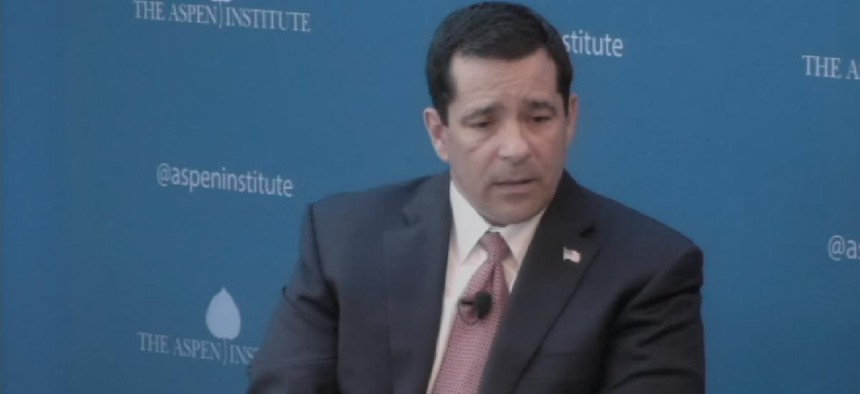Changes coming to clearance process in 30 to 60 days, says ODNI

A top national security official said that the Office of the Director of National Intelligence hopes coming changes will significantly reduce the existing backlog, which has ballooned to 700,000 in recent years.

Bill Evanina speaks at the Aspen Institute on April 18, 2018.
A top national security official said that the Office of the Director of National Intelligence will be putting out changes to the federal government’s security clearance procedures in the near future that it hopes will significantly reduce the existing backlog, which has ballooned to 700,000 in recent years.
William Evanina, director of the National Counterintelligence and Security Center, told attendees at an April 18 event hosted by the Aspen Institute that ODNI hopes to have new guidance out in the next 30 to 60 days that refines the questions background investigators are required to ask about applicants and condenses the front end of the clearance process so that candidates can start work while newer technologies like continuous monitoring conduct more granular analysis.
"We're going to recalculate and review how we look at risk, so when we want to give someone a top-secret clearance, what do we look at and what does trust mean?" said Evanina
"Some of the stuff that we look at now has been in place since [Aldrich] Ames and [Robert] Hanssen and the way our adversaries acted a long time ago," he said, adding that some of those processes no longer hold as much investigative value and are contributing to the backlog. In particular, he cited questions about an applicant’s debt and foreign travel as examples. According to Evanina, if an applicant has more than $7,000 in “bad” debt -- such as credit card debt -- a separate, more lengthy investigation is automatically triggered because financial distress is viewed as an indicator that a candidate could be more vulnerable to compromise or selling secrets down the road.
However, among households that have credit debt, the average debt burden is approximately $16,000, according to Experian, NerdWallet and other financial institutions. With such debt a common fact of life for millions of Americans, Evanina wondered how relevant those kinds of questions are today.
“If you ask folks who do this for a living, they say, 'Well, we’ve never really rejected anybody’s security clearance because of bad debt,'” he said. “So why are we spending so much time on it?”
Not everyone feels that way. Bradley P. Moss, an attorney who specializes in clearance and whistleblower cases, told FCW that although updates and revisions to the investigative and adjudicative criteria are welcome, it’s not clear whether Evanina’s suggestions would have a meaningful impact in addressing the core underlying problems driving the clearance backlog. He also questioned whether it was possible to disentangle questions about financial distress and foreign travel from the process without affecting national security.
"The adjudicative guidelines are certainly going to continue to retain disqualifying concerns that implicate both financial considerations and foreign influence. The idea that those considerations are going to be eliminated is pure fantasy," said Moss. "So although Mr. Evanina makes vague references to loosening the strictness of the investigative or adjudicative criteria, it’s not clear how that would truly be applied in practice."
In addition to the changes articulated by Evanina, ODNI must provide a more comprehensive clearance reform plan to Congress at the end of the year.
The federal government is in the midst of overhauling key elements and jurisdictional lines for its security clearance process, passing legislation late last year that will shift responsibility for Department of Defense personnel -- who make up the largest portion of the backlog -- from NBIB to DOD and the Defense Security Services in three years. Congress and members of the contracting community have expressed frustration over the enduring nature of the backlog, and the clearance process was added to the Government Accountability Office list of “high risk” government programs most in need of reform.
Another potential change coming down the pipeline is condensing the front end of the initial investigative phase to provide a minimum level of acceptable vetting in order to allow a candidate to start work while relying on technologies and processes like continuous monitoring and evaluation and insider threat analysis to do deeper background investigations.
"At the end of the day in my opinion, if you're a 23-year-old woman with a master's degree or a 26-year-old man and you’ve got that master's and you've worked for a company and you want to apply … that shouldn’t take more than 30 to 60 days, in my opinion, to get that in,” said Evanina.





